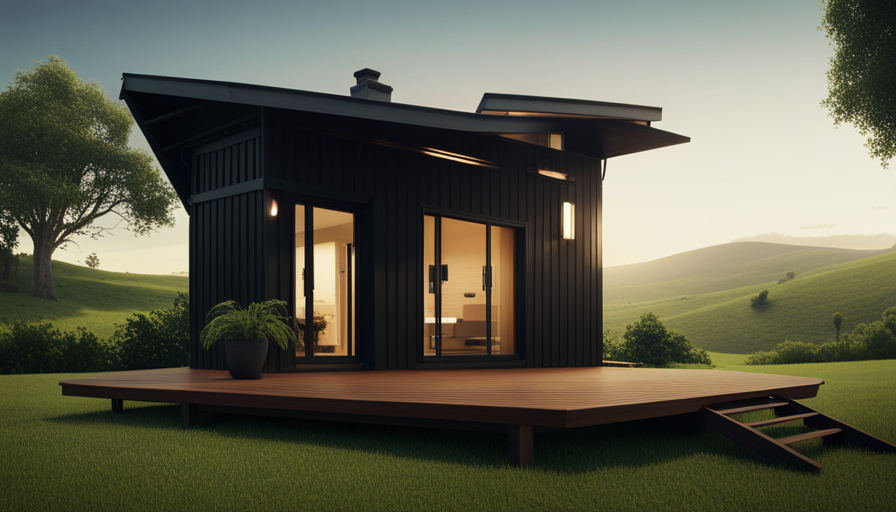As I sat on my couch, engrossed in an episode of the popular TV show ‘Tiny House Nation,’ a sudden thought struck me. The concept of living in a small home, embracing simplicity, self-sufficiency, and a connection with nature, seemed to align closely with the principles of transcendentalism.
Just like the transcendentalists of the 19th century, who sought to break free from societal constraints and embrace a more authentic way of living, the participants on ‘Tiny House Nation’ were making a conscious choice to downsize their lives and live in harmony with the environment.
This realization led me to delve deeper into the connection between the two, discovering surprising parallels and uncovering the influence of transcendentalism on the tiny house movement. In this article, we will explore how ‘Tiny House Nation’ embodies the ideals of transcendentalism, discuss its relevance in today’s society, and uncover other modern manifestations of these transcendentalist ideals.
So, grab a cup of tea and join me on this journey to discover transcendentalism in unexpected places.
Key Takeaways
- ‘Tiny House Nation’ aligns with the principles of transcendentalism, emphasizing simplicity, self-sufficiency, and a connection to nature.
- Living in a tiny house encourages a minimalist approach and a closer connection to the natural world.
- Tiny houses promote a sustainable and environmentally conscious way of living.
- The comparison between Tiny House Nation and transcendentalism provides insights into living intentionally, harmoniously, and in tune with nature.
Transcendentalism: A Brief Overview
Get ready to explore how Tiny House Nation connects to the philosophy of Transcendentalism! Transcendentalism, a philosophical movement that emerged in the 19th century, promotes the idea of self-reliance, individualism, and the importance of nature. It emphasizes the connection between humans and the natural world, advocating for a harmonious relationship with the environment.
This connection between transcendentalism and environmentalism is evident in the show Tiny House Nation. Tiny House Nation showcases the construction of small, eco-friendly homes that encourage sustainable living. By promoting the use of recycled materials, solar panels, and energy-efficient appliances, the show aligns with the principles of transcendentalism and its emphasis on mindfulness towards the environment.
The tiny houses featured on the show serve as a reminder of our interconnectedness with nature and the need to live in harmony with it. Furthermore, the concept of mindfulness, a central tenet of transcendentalism, can also be seen in Tiny House Nation. The show encourages individuals to be mindful of their consumption habits, to live with only what is necessary, and to focus on experiences rather than material possessions. This mindful approach to living aligns with the transcendentalist belief in the importance of inner reflection and self-awareness.
Tiny House Nation embodies the principles of transcendentalism through its promotion of environmentalism and mindfulness. The show serves as a reminder of the need to live in harmony with nature and to prioritize experiences over material possessions.
Now, let’s delve deeper into the principles of transcendentalism.
The Principles of Transcendentalism
Embracing the core principles of self-reliance and the pursuit of individual truth, Tiny House Nation resonates with the spirit of transcendentalism.
Transcendentalism, a philosophical movement that emerged in the 19th century, emphasized the importance of personal growth and living in harmony with nature. In today’s contemporary lifestyle, where consumerism and materialism often dominate, applying transcendentalism can provide a refreshing perspective on how we approach our lives.
Applying transcendentalism to personal growth allows individuals to break free from societal expectations and discover their own truths. It encourages us to rely on our own intuition and inner wisdom, rather than conforming to external influences. By simplifying our lives, we can focus on what truly matters and find fulfillment in the pursuit of our passions and values.
Incorporating the principles of transcendentalism into the design and lifestyle of tiny houses aligns with its emphasis on simplicity and connection with nature. Living in a tiny house encourages a minimalist approach, where individuals prioritize experiences and relationships over material possessions. It allows for a closer connection to the natural world, as many tiny houses are designed to be sustainable and environmentally friendly.
Transitioning into the subsequent section about ‘Tiny House Nation: Exploring the Show,’ we can see how the principles of transcendentalism are brought to life through the innovative designs and stories of individuals who choose to live in tiny houses.
Tiny House Nation: Exploring the Show
One couple’s journey to downsizing their lifestyle and building their dream home on wheels captured the hearts of viewers on the hit show Tiny House Nation. The show, which explores alternative housing options, has had a significant impact on sustainable living. By showcasing the benefits of living in a tiny house, Tiny House Nation encourages viewers to reconsider their own living arrangements and embrace a simpler, more sustainable lifestyle.
The show highlights the ways in which tiny houses promote sustainable living. With their smaller size, these homes require fewer resources to build and maintain. They often utilize renewable energy sources such as solar power and rainwater collection systems, reducing the environmental impact. Additionally, tiny houses encourage a minimalist approach to possessions, promoting a more mindful and environmentally conscious way of living.
Tiny House Nation also emphasizes the importance of community and connection. Many tiny house owners choose to live in intentional communities or share land with others, fostering a sense of belonging and cooperation. This sense of community aligns with the principles of transcendentalism, which emphasizes the connection between individuals and nature.
Tiny House Nation explores alternative housing options and their impact on sustainable living. The show’s focus on minimalism, renewable energy, and community reflects the principles of transcendentalism.
Parallels Between Tiny House Nation and Transcendentalism
In Tiny House Nation, there are several key points that parallel with the principles of transcendentalism. One of these is the emphasis on embracing simplicity and minimalism. The show encourages people to downsize their living spaces and focus on what truly matters, which aligns with the transcendentalist belief in living a life free from unnecessary material possessions.
Additionally, Tiny House Nation promotes connecting with nature, as many of the tiny houses are located in beautiful natural settings, allowing individuals to reconnect with the environment and appreciate its beauty.
Lastly, the show challenges materialistic values by showcasing how happiness can be found in experiences and relationships rather than in the accumulation of material wealth, promoting self-reliance and individual freedom.
Embracing Simplicity and Minimalism
Explore the freedom of living with less and discover the profound beauty in simplicity through the captivating journey of the tiny house movement. Tiny House Nation exemplifies the principles of transcendentalism by embracing a minimalist lifestyle and highlighting the benefits of simplicity.
In each episode, homeowners are faced with the challenge of downsizing their possessions and creating a functional living space within a small footprint. This process encourages individuals to evaluate their materialistic desires and prioritize what truly brings them happiness and fulfillment. By embracing a minimalist lifestyle, individuals can free themselves from the burden of excessive possessions and find joy in the simplicity of their surroundings.
This connection between the tiny house movement and transcendentalism is further strengthened by the emphasis on nature and the outdoors. The small size and mobility of tiny houses allow for a closer connection with nature, as homeowners can easily relocate their homes to different natural settings.
This connection with nature will be further explored in the subsequent section, highlighting the importance of reconnecting with the natural world.
Connecting with Nature
By immersing ourselves in the serenity of the natural world, we can tap into our inner peace and find solace in the simplicity of nature’s embrace. Connecting with nature allows us to break free from the chaos and distractions of modern life, enabling us to reconnect with our true selves.
1) Nature’s beauty: The breathtaking landscapes and awe-inspiring wonders of the natural world remind us of the grandeur and magnificence of the universe. It humbles us and puts our worries and materialistic desires into perspective.
2) Healing power: Spending time in nature has been scientifically proven to reduce stress, improve mental health, and enhance overall well-being. The sights, sounds, and smells of nature have a calming effect on our minds, helping us to find inner peace.
3) Environmental consciousness: Being in nature fosters a sense of responsibility and appreciation for the environment. It reminds us of the importance of preserving our planet for future generations.
Embracing simplicity and connecting with nature go hand in hand, as both allow us to break free from the constraints of materialism and find true fulfillment.
In the next section, we will explore how Tiny House Nation challenges materialistic values in our society.
Challenging Materialistic Values
Challenging our obsession with material possessions can be a liberating experience that opens our eyes to the true sources of happiness and fulfillment. In the context of transcendentalism and consumerism, exploring the tiny house movement exemplifies this notion.
Transcendentalism, a philosophical movement that emerged in the 19th century, emphasizes the importance of self-reliance, individual freedom, and a connection to nature. The tiny house movement aligns with these values by encouraging individuals to simplify their lives, detach from materialistic desires, and focus on what truly matters. By living in a small space, people are forced to prioritize their needs and let go of unnecessary possessions. This shift in mindset challenges the consumerist culture that often dictates our lives. It allows us to reevaluate our values and find contentment in experiences and relationships rather than material possessions.
Transitioning into the subsequent section about promoting self-reliance and individual freedom, we will explore how tiny house living fosters independence and empowers individuals to live life on their own terms.
Promoting Self-Reliance and Individual Freedom
How can living in a small space empower individuals to take control of their own lives and embrace their independence? The answer lies in the self-sufficiency and minimalist lifestyle that comes with tiny house living.
By choosing to live in a small space, individuals are forced to declutter and prioritize their possessions, only keeping what’s truly necessary. This minimalist lifestyle encourages self-reliance and a focus on what truly matters, allowing individuals to break free from the materialistic values that often consume our society.
Living in a tiny house promotes a sense of freedom and independence, as individuals aren’t tied down by excessive belongings or a large mortgage. Instead, they have the opportunity to live a simpler, more intentional life.
This shift towards self-sufficiency and embracing individual freedom is a key aspect of the influence of transcendentalism on the tiny house movement.
The Influence of Transcendentalism on Tiny House Movement
As an avid fan of both Tiny House Nation and Transcendentalism, I’m fascinated by the influence of transcendentalist ideas on the tiny house movement.
One key aspect is the emphasis on simplicity and minimalism in both philosophies, as they both advocate for a pared-down lifestyle that focuses on the essentials.
Additionally, the tiny house movement is inspiring alternative housing solutions by challenging conventional notions of what a home should be, just as transcendentalism encourages individuals to think outside the box and question societal norms.
Lastly, both the tiny house movement and transcendentalism foster a sense of connection and harmony with nature. They prioritize sustainable living and encourage people to live in closer proximity to the natural world.
Transcendentalist Ideas in Modern Living
Imagine living in a tiny house, where simplicity and self-reliance are celebrated, embodying the transcendentalist ideals of modern living.
Transcendentalist ideas have had a significant impact on urban living, influencing the tiny house movement and inspiring alternative housing solutions. In today’s fast-paced and materialistic world, many individuals are seeking a simpler, more sustainable way of life.
Tiny houses, with their minimalistic design and focus on self-sufficiency, provide a perfect example of how transcendentalist ideas can be incorporated into modern homes. These homes often feature large windows, allowing natural light to flood in and creating a connection with the surrounding environment. Additionally, tiny houses often have gardens or green spaces, bringing nature into the urban setting.
This integration of nature and simplicity not only promotes a healthier and more balanced lifestyle but also encourages a deeper connection with the natural world.
Transitioning to the subsequent section about inspiring alternative housing solutions, the tiny house movement offers a glimpse into a more mindful and intentional way of living.
Inspiring Alternative Housing Solutions
In exploring the influence of Transcendentalist ideas on modern living, it is fascinating to see how these principles have manifested in alternative housing trends. One such trend that aligns with the Transcendentalist belief in living simply and in harmony with nature is the rise of tiny houses. This movement, epitomized by shows like "Tiny House Nation," promotes the idea of downsizing and living in compact, sustainable dwellings.
To illustrate the impact of tiny houses on sustainable living, I have created a table that compares the environmental benefits of tiny houses versus traditional homes:
| Environmental Benefits of Tiny Houses | Environmental Impact of Traditional Homes |
|---|---|
| Reduced carbon footprint | Higher energy consumption |
| Less waste generation | More construction materials required |
| Lower water usage | Increased water consumption |
By embracing alternative housing solutions like tiny houses, individuals can actively contribute to a more sustainable future. This commitment to sustainable living not only fosters a sense of connection and harmony with the natural world but also promotes a more balanced and environmentally conscious lifestyle.
Fostering a Sense of Connection and Harmony
Fostering a sense of connection and harmony can be achieved by embracing alternative housing options that align with the principles of Transcendentalism, such as the trending movement of compact, sustainable dwellings. These tiny houses not only provide a physical space for individuals or families to live, but they also encourage a deeper connection to the natural world and a stronger sense of community.
-
Connection and community: Living in a tiny house often means being part of a close-knit community of like-minded individuals who share similar values and beliefs. This sense of community fosters connections and encourages collaboration, creating a support network that goes beyond the physical boundaries of the tiny house.
-
Sustainable living: Tiny houses are typically designed with sustainability in mind. They often utilize environmentally friendly materials, incorporate energy-efficient systems, and encourage a minimalist lifestyle. By living in a tiny house, individuals can reduce their ecological footprint and live in harmony with nature.
-
Sense of purpose: Embracing alternative housing options like tiny houses can also help individuals find a deeper sense of purpose and fulfillment. By simplifying their lives and focusing on what truly matters, people can align their actions with their values and live a more meaningful life.
Transitioning into the subsequent section about criticisms and limitations of the comparison, it is important to acknowledge that while tiny houses can foster a sense of connection and harmony, they’re not without their challenges.
Criticisms and Limitations of the Comparison
However, you may encounter some valid criticisms and limitations when drawing a comparison between Tiny House Nation and transcendentalism. While it’s true that both embody a desire for simplicity and harmony with nature, it’s important to acknowledge the critiques of this comparison.
One key critique is that Tiny House Nation primarily focuses on the physical aspects of living in a small space, such as design and functionality, whereas transcendentalism is a philosophical movement that encompasses a broader range of ideas and values. This limitation reduces the depth of the comparison and fails to capture the spiritual and intellectual elements of transcendentalism.
Furthermore, some argue that Tiny House Nation promotes a consumerist mindset, as it often highlights the latest trends and gadgets in small living. This emphasis on material possessions contradicts the core tenets of transcendentalism, which emphasizes the importance of non-conformity and self-reliance. Additionally, while Tiny House Nation encourages a connection with nature through sustainable practices, it doesn’t address the larger systemic issues that contribute to environmental degradation.
Despite these limitations, the comparison between Tiny House Nation and transcendentalism can still provide valuable insights into the relevance of transcendentalism in today’s society. By examining the overlap between these two concepts, we can gain a better understanding of how we can live more intentionally, harmoniously, and in tune with nature in our modern world.
Transcendentalism’s Relevance in Today’s Society
Today, the principles of transcendentalism continue to resonate with individuals seeking a deeper connection with themselves, others, and the natural world. Transcendentalist philosophy in education serves as a pathway for personal growth and self-discovery. By encouraging students to explore their own thoughts and beliefs, this approach fosters critical thinking and creativity. It emphasizes the importance of individuality and encourages students to trust their own instincts and intuition.
Applying transcendentalism in business can lead to a more holistic and ethical approach. By prioritizing the well-being of employees and the environment, businesses can create a more sustainable and fulfilling work environment. This philosophy promotes the idea that success is not solely measured by financial gain, but by the positive impact a business has on society.
Furthermore, the principles of transcendentalism can be applied in various aspects of modern life. Whether it is through practicing mindfulness and meditation, embracing nature and its healing powers, or seeking meaningful connections with others, individuals can incorporate these ideals into their daily lives.
The principles of transcendentalism continue to hold relevance in today’s society. They offer guidance in education, inspire ethical business practices, and provide a framework for personal growth. Other modern manifestations of transcendentalist ideals can be seen in various aspects of life, demonstrating the enduring impact of this philosophy.
Other Modern Manifestations of Transcendentalist Ideals
Another way that transcendentalist ideals can be seen in modern life is through the growing popularity of mindfulness and meditation practices. These practices encourage individuals to connect with their inner selves and the natural world around them, which aligns with the transcendentalist belief in finding truth and meaning through personal experience and intuition.
One modern manifestation of transcendentalist ideals can be seen in the popularity of tiny houses. Tiny houses embrace the principles of simplicity and minimalism, which were central to the transcendentalist philosophy. By living in small, efficient spaces, individuals can reduce their environmental footprint and live more sustainably. This emphasis on environmental sustainability is another connection to transcendentalism, as the movement placed a strong emphasis on the inherent value of nature and the need to live in harmony with the natural world.
Modern architecture also reflects transcendentalist ideals in its focus on blending man-made structures with the natural environment. Many contemporary architects strive to create buildings that seamlessly integrate with their surroundings, utilizing natural materials and incorporating elements of nature into their designs. This approach echoes the transcendentalist belief in the unity of all things and the importance of living in harmony with nature.
The growing popularity of mindfulness and meditation practices, as well as the emphasis on modern architecture and environmental sustainability, demonstrate the continued relevance of transcendentalist ideals in today’s society. These ideals can be seen in various aspects of modern life, reflecting a continued appreciation for the principles and values espoused by the transcendentalist movement.
This connection between transcendentalist ideals and modern manifestations sets the stage for exploring the legacy of transcendentalism in popular culture.
The Legacy of Transcendentalism in Popular Culture
The influence of transcendentalism can be felt like a gentle breeze weaving its way through the tapestry of popular culture. This philosophical movement, which originated in the early 19th century, has left a lasting impact on various forms of artistic expression.
Transcendentalism in literature, for instance, can be seen in the works of renowned authors such as Ralph Waldo Emerson and Henry David Thoreau. Their writings, characterized by a deep appreciation for nature and a rejection of societal norms, continue to inspire readers today.
Music is another area where the legacy of transcendentalism is apparent. Artists like Bob Dylan and Joni Mitchell have incorporated transcendentalist ideals into their lyrics, promoting a sense of individuality and a connection to the natural world. Through their songs, they encourage listeners to question authority and find solace in the beauty of the world around them.
Finding transcendentalism in unexpected places is not uncommon in popular culture. Whether it’s in the pages of a novel or the lyrics of a song, the influence of this philosophical movement can be found in various forms of artistic expression. It serves as a reminder to embrace our individuality, seek spiritual connection, and appreciate the wonders of nature.
Conclusion: Finding Transcendentalism in Unexpected Places
Embrace the hidden gems of transcendentalism that await your discovery in the unlikeliest of places. When we think of transcendentalism, we often associate it with the works of Ralph Waldo Emerson and Henry David Thoreau, or with nature and self-reliance. However, this philosophical movement can also be found in unexpected corners of popular culture, such as the reality TV show "Tiny House Nation."
"Tiny House Nation" explores unconventional lifestyles by showcasing individuals who have chosen to live in tiny homes. These homeowners have made a conscious decision to simplify their lives, reduce their material possessions, and live in harmony with nature. This aligns with the core principles of transcendentalism, which emphasize the importance of simplicity, self-reliance, and a deep connection with the natural world.
To illustrate the connection between "Tiny House Nation" and transcendentalism, consider the following table:
| Transcendentalism | "Tiny House Nation" |
|---|---|
| Simplicity | Living in a tiny home forces individuals to simplify their lives and prioritize what truly matters. |
| Self-reliance | Homeowners must rely on themselves to build and maintain their tiny homes, fostering a sense of self-sufficiency. |
| Connection with nature | Many tiny homes are built in remote locations, allowing homeowners to live in closer proximity to nature and appreciate its beauty. |
| Nonconformity | By choosing to live in a tiny home, individuals are breaking away from societal norms and embracing an unconventional lifestyle. |
By finding transcendentalism in unexpected places like "Tiny House Nation," we are reminded of the enduring relevance of this philosophical movement. It encourages us to explore unconventional lifestyles and seek fulfillment in simplicity, self-reliance, and a deeper connection with nature.
Frequently Asked Questions
How many seasons of Tiny House Nation are there?
There are six seasons of Tiny House Nation. Each season showcases the journey of families and individuals as they downsize their homes and embrace a simpler way of living.
The show emphasizes the benefits of downsizing, such as reduced costs of materials and increased financial freedom. By exploring the challenges and rewards of tiny living, Tiny House Nation offers viewers an insightful and analytical perspective on the potential for a more intentional and meaningful lifestyle.
What is the average cost of building a tiny house?
The average cost of building a tiny house can vary depending on factors such as location, materials used, and customization. However, a rough estimate is around $20,000 to $50,000.
The building process of a tiny house involves careful planning, design, and construction. It requires a lot of attention to detail and creativity to make the most of the limited space available.
Overall, building a tiny house can be a cost-effective and sustainable housing option.
Are there any famous individuals who have embraced the Tiny House Movement?
Though it may seem unconventional, there are indeed famous individuals who’ve embraced the tiny house movement. These individuals, ranging from actors to musicians, have found solace and simplicity in living small.
While the benefits of the tiny house movement include financial freedom and environmental sustainability, there are also drawbacks to consider, such as limited space and the challenges of living off the grid. Nonetheless, these famous pioneers have shown that living in a tiny house can be a fulfilling and intentional lifestyle choice.
Can you explain the role of nature in Transcendentalism?
The role of nature in transcendentalism is central to its philosophy. Nature is seen as a source of inspiration and a means of connecting with the divine.
Transcendentalists believe that spending time in nature allows one to gain a deeper understanding of oneself and the world. It emphasizes the importance of simplicity, as nature is seen as pure and untainted by societal influences.
By immersing oneself in nature, one can achieve spiritual enlightenment and a sense of harmony with the universe.
Are there any negative aspects to living in a tiny house?
Living in a tiny house, like any lifestyle choice, has its pros and cons. While some may find it liberating and a way to simplify their lives, there can be negative aspects as well.
The limited space can be challenging and may not be suitable for everyone. Additionally, the cost of building a tiny house can be high, and it requires careful planning and budgeting.
However, these challenges can be overcome with proper preparation and a willingness to adapt.
Conclusion
In conclusion, the connection between Tiny House Nation and transcendentalism is an unexpected but fascinating one. The show’s emphasis on simplicity, self-sufficiency, and a rejection of materialism aligns with the key principles of transcendentalism.
The influence of transcendentalism on the tiny house movement is evident, as many individuals who choose to live in tiny homes are seeking a more meaningful and intentional way of life. Transcendentalism’s relevance in today’s society is evident in the growing popularity of minimalism and the desire for a more authentic and connected existence.
While transcendentalism may seem like a dated philosophy, its ideals continue to resonate in unexpected ways, reminding us to question societal norms and seek a deeper understanding of ourselves and the world around us.
Hi, I’m Emma. I’m the Editor in Chief of Tiny House 43, a blog all about tiny houses. While tree houses are often associated with childhood, they can be the perfect adult retreat. They offer a cozy space to relax and unwind, surrounded by nature. And since they’re typically built on stilts or raised platforms, they offer stunning views that traditional homes simply can’t match. If you’re looking for a unique and romantic getaway, a tree house tiny house might just be the perfect option.










